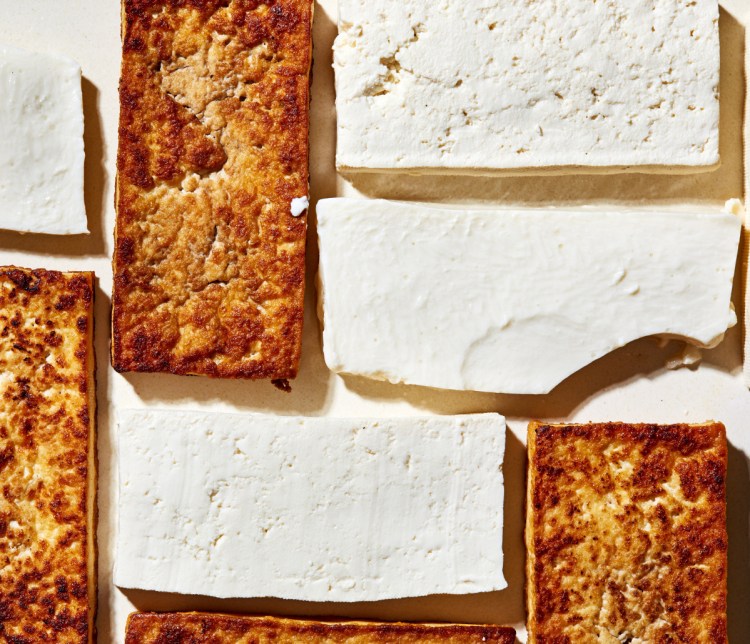Tofu has long since ceased to be a special ingredient, especially now that meatless eating has become mainstream. But it still confounds some of us.
Perhaps because it’s so versatile – you can do so much with it, you may not know where to start. Plus, it often takes a little extra work to get the best results.
If you’re interested in improving your tofu IQ, here are four points to consider.
• Know the types. All tofu starts with milk from ground soybeans. Salt and other ingredients are added to form curds, which are drained to varying degrees to form products of different consistencies. Common types of block tofu are extra-firm, firm and soft. Silken tofu goes through a slightly altered process and is not drained, giving it a smooth, custard-like texture.
Another more recent addition to the field is sprouted tofu, which is made with soy beans that have sprouted; proponents argue that makes it easier to digest and a better source of certain nutrients. Most tofu you’re likely to see at your grocery store is packed in water, but you may come across other tofu that is vacuum-packed or in shelf-stable cartons.
In “This Can’t Be Tofu!” (written way back in 2000), chef and cookbook author Deborah Madison said that firm (you may see it labeled as “regular”) tofu was her all-purpose choice. “If you’re going to buy tofu but don’t know how you’re going to use it, you’ll be safest buying regular or firm tofu,” she wrote.
• Prep it. For many of the most common applications (pan-frying/sauteing, baking, etc.), you’re going to want to drain and then dry water-packed tofu. Most often I do this by cutting it into slabs or cubes and letting it rest on a few layers of paper towels spread on a rimmed baking sheet while I prep other recipe ingredients.
If you really want to press out a lot of liquid, you can wrap the block of tofu in several layers of paper towels and place it between two trays or plates, the top of which is weighted with something heavy, such as a large can of tomatoes.
Another option: Set the drained and wrapped tofu blocks on a microwave-safe plate and microwave on HIGH for 30 seconds. Remove the paper towels, rewrap the tofu with fresh ones, and microwave on HIGH for another 30 seconds. Repeat one or two times, until the tofu is noticeably firmer.
Madison is not a believer in tofu’s effectiveness at soaking up marinades. She says those flavored liquids primarily penetrate the surface of the tofu, but you can improve the bean curd’s absorbency by freezing it before you marinate. Freezing tofu causes the water to expand, leaving behind pockets of air that allow more marinade or sauce to penetrate.
Tofu that has been frozen also gets a little closer to the texture of meat, with a spongier, chewier consistency. (You can freeze any type of tofu for long-term storage. Your other option is to keep leftovers in the refrigerator for up to a week, submerged in water you change daily.)
You can brown or saute tofu in a dry skillet or one with a little oil. This, Madison says, keeps the tofu from falling apart and adds flavor as well.
One of my favorite ways to precook it involves seasoning slabs or cubes with salt and pepper, coating them in cornstarch and then pan-frying in oil until golden on all sides. This is especially good for dishes such as pad thai and sandwiches.
• Cook it, and be obvious about it. You can do almost anything with tofu, but what you do depends somewhat on which type you’re using. Madison suggests frying, sauteing or grilling firm tofu. Soft is good for serving simply with a sauce or garnish, as well as standing in for eggs in a scramble.
Extra-firm holds up to frying or grilling, too. Silken tofu is especially at home in soups, on top of salads and in desserts.
A vegetarian version of chicken salad is a natural place for tofu, especially when the tofu is smoked.
Madison suggests tofu as a nondairy substitute for paneer, a firm cheese in Indian cuisine. You can braise it in a coconut milk sauce, such as in a Thai curry. Wrap matchsticks of tofu with vegetables in rice paper for a Vietnamese spring roll. That’s just a start.
• Make it disappear. I’m not advocating you try to pull a fast one by hiding tofu in dishes you serve to family members and friends. But tofu does lend itself to melding seamlessly into a variety of foods, including as a substitute for non-vegan ingredients.
It can add body to dishes, too. Madison recommends using two ounces of pureed silken tofu to replace each egg in a recipe for pancakes, muffins, quick bread or cake. Or you can use the tofu in addition to eggs or even in conjunction with only egg whites. Just be sure the tofu has been blended until it’s completely smooth.
Think about blending tofu into smoothies and salad dressings. Puree it with water to add it to a batter for falafel and other fritters. Thicken soup by blending some of it with tofu and then adding the mixture back to the pot.
Copy the Story LinkSend questions/comments to the editors.



Success. Please wait for the page to reload. If the page does not reload within 5 seconds, please refresh the page.
Enter your email and password to access comments.
Hi, to comment on stories you must . This profile is in addition to your subscription and website login.
Already have a commenting profile? .
Invalid username/password.
Please check your email to confirm and complete your registration.
Only subscribers are eligible to post comments. Please subscribe or login first for digital access. Here’s why.
Use the form below to reset your password. When you've submitted your account email, we will send an email with a reset code.